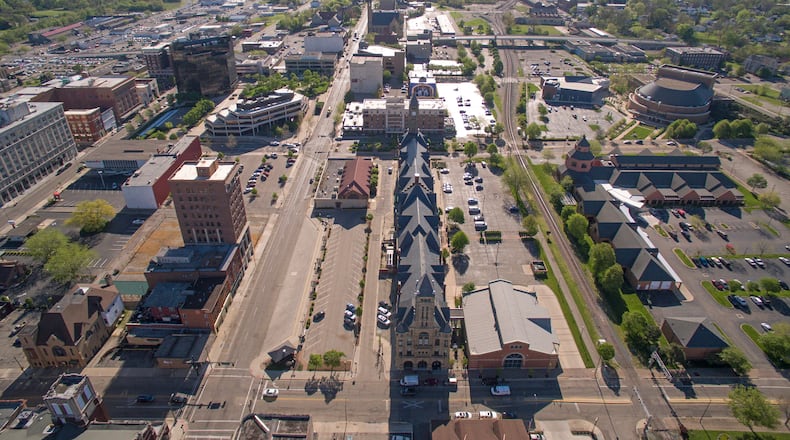For his son, Rick, who was looking forward to his senior year at Springfield North High School and was a drummer in a band that, in the era of psychedelia, switched its name back and forth from the Gum Drop Trilogy to the Isles of White, the move was clearly a bummer.
Whether the untimely departure deepened the boy’s sense of connection with the Champion City isn’t clear. But while looking out the windows of the Un Mundo café recently at the tracks that once carried Big Four trains through downtown Springfield, Giles, now 66, laughed appreciatively at the suggestion that his dreams for a tribute to his hometown railroad may have not just grown but metastasized.
What had started as a project to build a layout showing the Ohio State Limited pulling up on Washington Street beside the iconic and beloved Big Four Depot has turned into a vision that has Giles considering taking a wall out in his basement to make enough room for a model of the Big Four from Springfield to the “hump yard” in Sharonville and maybe even to the Procter and Gamble yard in Ivorydale.
Just as he’d go downtown from Home Orchards area to watch the Limited arrive at 5:15 p.m. during his youth, “I’d leave the windows open (at night) and I’d hear the trains whistle for the crossing at Kensington (Street). There’s always that romantic thing about trains in the distance,” though Giles points out that, by then, the sounds were coming from a diesel engine horn instead of the whistle of a steam locomotive.
That detail about the whistle speaks to the depth of knowledge and level of authenticity he brings to his quest. Giles called my home hoping that I’d be able to help him track down a photo of the West End tower, one of six in Springfield. Giles wants an original print. The copy he has from a 1950s newspaper isn’t making the grade.
Different from the towers on other sections of the New York Central, fans of the Big Four love them for their “spindly looking” design. Instead of being walled off on both the first and second floors, the first floors of the Big Four Towers were open, laying bare the lock levers tower operators pulled to switch trains from track to track. The structures were called arm-strong towers in the days before pneumatics and electricity powered them to reflect the strength required to operate the switches.
“These guys didn’t look like Charles Atlas,” Giles said, “but they had a technique.”
Just as the late Bill Swonger chose 1940 for his masterly model of downtown Springfield that has been such a wonderful contribution to the annex of the Clark County Heritage Center, Giles has a period in mind: 1954-62.
A model layout of that era “could run steam and diesel at the same time,” he said. “I’ve collected the locomotives and several dozen passenger and freight cars from that era,” a time in which Big 4 cars transitioned from a rusty red to green.
But Giles has more in mind recreating the railroad’s appearance. “I like the intricacy of actually creating an operating miniature railroad,” he said – of replicating the myriad movements of cars from the main tracks to spurs to serve customers and switching train to sidetracks to accommodate the flow on the main line.
As the operator of such a railroad, “You go out and you solve a complex puzzle every day.”
What’s more, the puzzle’s moving parts would reassemble this region of Ohio when it was an industrial powerhouse, in the days the tracks skirted the edges of factories and sometimes went into them.
In addition to the Springfield factories – and the railroad’s large Warder Street yard and roundhouse of the time – he envisions his layout including two large cement plants in Fairborn; the Union Terminal in Dayton; the Frigidaire works in Moraine; a paper mill in West Carrolton; the Mound Laboratory in Miamisburg; paper mills and fuel facilities in Franklin; and the Armco Steel works in Middletown.
It’s not clear how he will fit all this into the basement of his 1922 house while leaving room for a furnace and washer and dryer.
That he’s seriously thinking about it is a clear sign that Giles, back from California a year now, is running down a dream that began when a train whistle that sounded near the Kensington Street crossing came into his bedroom window on summer’s night long ago.
About the Author
